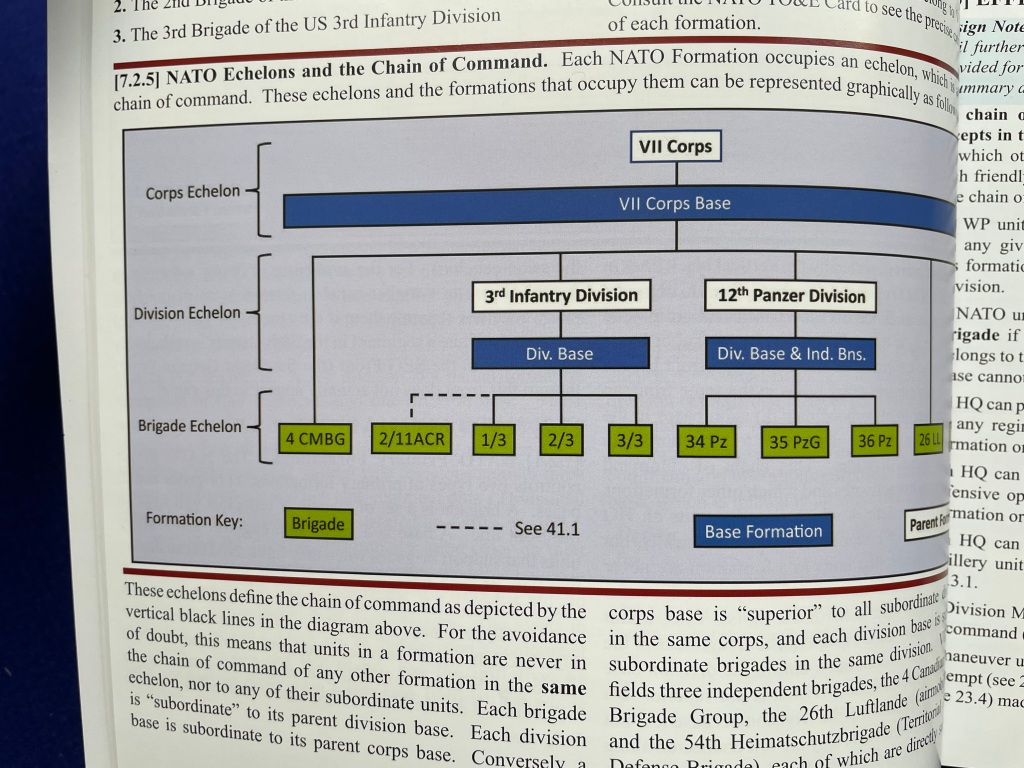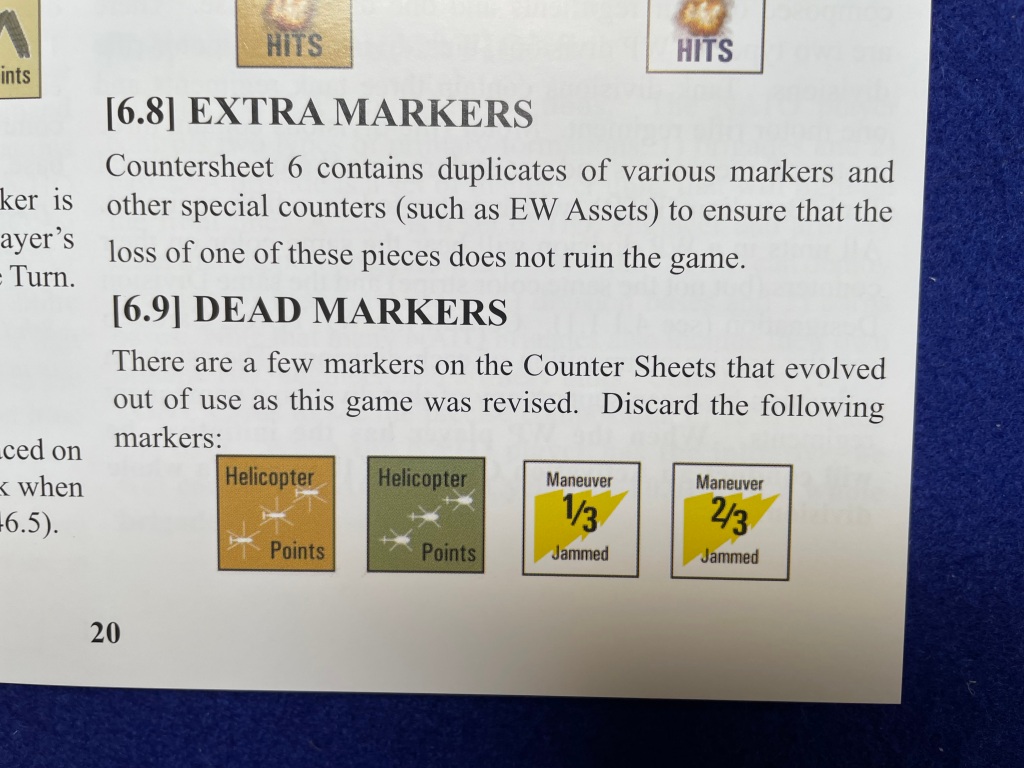Given my expectation that Bruce Maxwell’s Air & Armor: Wurzburg – Designer’s Signature Edition from Compass Games (2024) is a complex game to learn, I am working my way through my initial reading of the rule book as recommended.
Maxwell’s recommended approach to learning Air & Armor is to read the rule book up thru case 23.0. There is a nice division within those rules between what I loosely term “game background” and “game play.” The goal of my first tranche of reading is to get through the game background.
In the Air & Armor rule book the game background covers the first eight cases of rules:
- [1.0] INTRODUCTION
- [2.0] GAME COMPONENTS
- [3.0] GLOSSARY
- [4.0] UNIT COUNTERS
- [5.0] STEP MARKERS
- [6.0] GAME MARKERS
- [7.0] FORMATIONS
- [8.0] GAME OVERVIEW
I covered [1.0] INTRODUCTION in a previous post. On first reading of [2.0] GAME COMPONENTS little jumps out to me with the exception that Air & Armor will be a table hog. When playing the full game, the two 22″x34″ maps use all my usual gaming table leaving no space for the several 8.5″x11″ cards needed to support play. As I have yet to punch out my counters, the advice given in [2.5.1] Counter Storage that recommends sorting units by Warsaw Pact (WP) division or by NATO brigade is welcome.
Section [3.0] GLOSSARY starts out with the warning, “Design Note: Even veteran gamers should read this section.” I consider myself a veteran gamer but nonetheless heed the advice. The terminology used in Air & Armor is generally not that different than what one might reasonably expect when wargaming a Cold War situation. That said, the designer uses some terms in a bit of a different way. One difference that stands out to me is the use of the term “Base.” In Air & Armor the term “Base” does not equate to a facility or a location but rather a formation as an element of command & control (C2):
- Army Base: A primary formation consisting of all HQ, artillery, and engineer units directly attached to the same WP army (see 7.1).
- Base Formation: All HQ, artillery and engineer units attached directly to a common parent formation (a division, corps, army, or front).
- Base Unit: Any unit belonging to a base formation.
- Corps Base: A primary formation consisting of all HQ, artillery, and engineer units attached directly to the same NATO corps (see 7.2.3).
- Division Base: All units bearing a white color stripe and same Division Designation (the number after the slash in their Unit Designations, see 4.1.1.1).
- Front Base: All HQ, artillery, and engineer units attached directly to the same WP front.
Case [4.0] UNIT COUNTERS is lavishly illustrated with many examples. I was ready to skim the section when I noticed [4.5] UNIT ERRATA:
As I commented in a previous post, these instances of errata in Air & Armor are a bit concerning. If there is a silver lining to this particular set of errata, perhaps it is that the publisher caught the misprinted counters in time to order up that sixth counter sheet of replacements and include them in the initial game release. Similar situations in other games from other publishers occasionally resulted in an initial release with bad components necessitating replacements from the publisher at an indeterminate time in the future. So, good on Compass Games?
Case [5.0] STEP MARKERS in the Air & Armor rule book is short; and it sets me a bit on edge. Generally speaking, I am not a fan of unit markers as I consider them nuisances on a game map. I dislike towering stacks of counters as they are often both unwieldily and well as fiddly. Stacks of unit markers are in themselves a form of complexity and I already wonder if there is a way to limit this added layer of game complexity. We shall see…
Knowing I am already not a fan of Step Markers, the next section of the Air & Armor rule book, [6.0] GAME MARKERS should be driving me insane. The reality, thankfully, is that many of the Game Markers do not end up on the game map but instead are used on the various game cards and tracks. While that is good with less markers on the map, it also is a “fiddly” warning that there is game play complexity driven by the need to associate game map activities with various tracks. Oh yeah, more errata:
The next section of the rule book for Air & Armor is [7.0] FORMATIONS. This rule is very important as it ties directly to the Sequence of Play for initiative and activations. It is also, in my opinion, overly complex in the way it is delivered. Basically, Maxwell takes almost four pages to explain how formations are composed of maneuver (combat) units and assets (HQ, artillery, and engineer). While the graphics in the rule book are much appreciated and tell pretty much the entire story, the textual explanation is, frankly, puzzling and yet another example of taking a simple concept and making it more complex that in needs to be. For example, in the formation graphic is a fairly easy to understand line-and-block diagram of the chain of command:

The rules text, however, starts by listing units from the bottom up:
The most important sub-rule is found near the end of the section in [7.3] EFFECT OF CHAIN OF COMMAND which starts in bold text, “The chain of command is one of the most important concepts in this game. It defines how a formation activates and which other formations it can support.” This appears to me to be an example of where a game mechanism that is relatively simple in concept is “explained” in a long, overwrought rule. Once again, I find myself wondering about the complexity of the game and whether it is the game mechanisms that are complex or the rules explanations.
The final section of the “play background” section of the Air & Armor rule book is [8.0] GAME OVERVIEW. The Design Note at the beginning of this section is worth noting:
Design Note: Air & Armor is played using a set of three nested action cycles. The structure of each cycle is designed to allow players to address the complexities of every major game function at one specific time, leaving players free to disregard that complexity at all other times.
[8.0] GAME OVERVIEW
I will say it yet again; Air & Armor in concept does not appear to be a very complex game. The Sequence of Play (SOP) is understandable and, if Maxwell delivers on their promises, well documented on the various player aid cards.
Which means that the “easy” learning part of the rules are likely over now because the next sections, from [9.0] SEQUENCE OF PLAY to [23.0] STRIKES are the rules for the various game mechanisms like initiative and operations, movement, and combat. With 26 pages of rules read that leaves only ~70 pages left before the first learning pass of the rule book is complete.
Feature image by RMN
The opinions and views expressed in this blog are those of the author alone and are presented in a personal capacity. They do not necessarily represent the views of U.S. Navy or any other U.S. government Department, Agency, Office, or employer.
RockyMountainNavy.com © 2007-2024 by Ian B is licensed under CC BY-SA 4.0 ![]()



